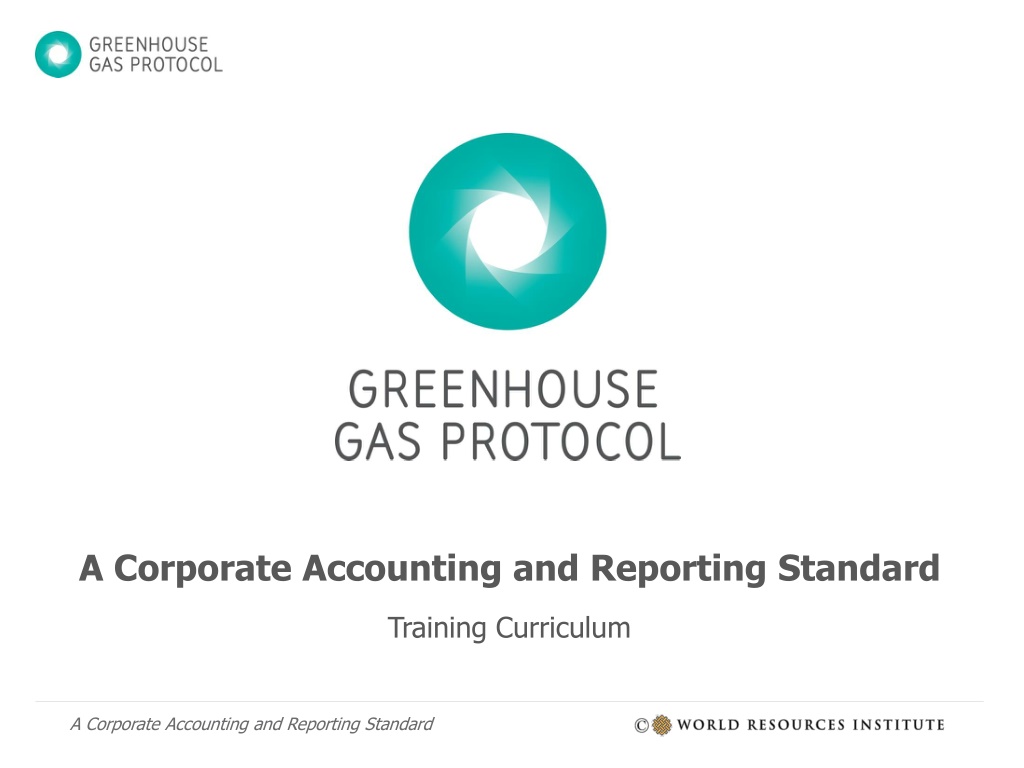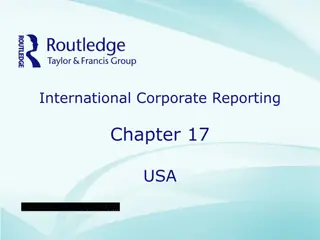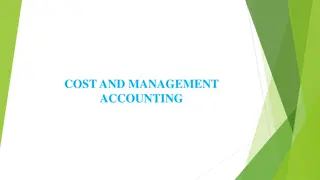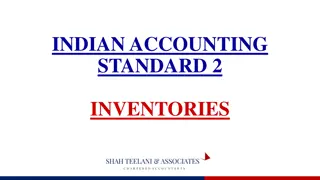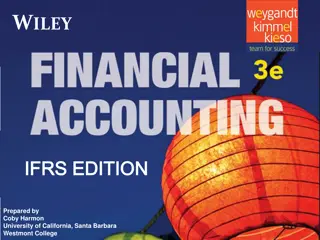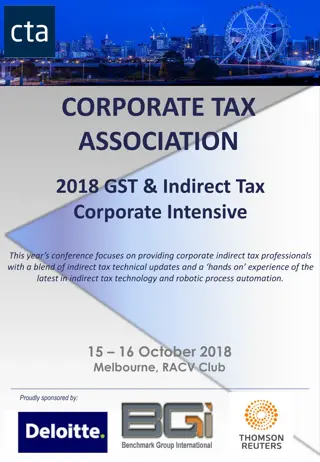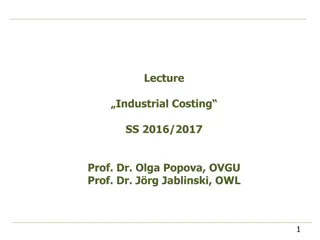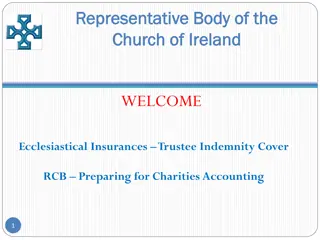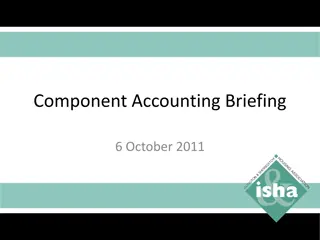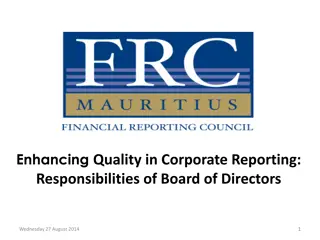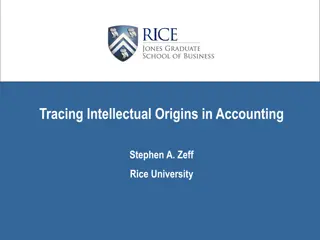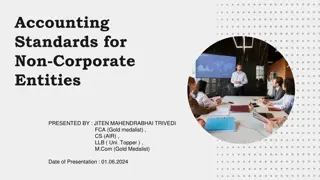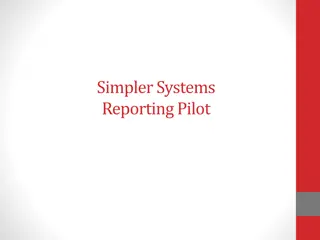A Corporate Accounting and Reporting Standard
This training curriculum covers principles of GHG accounting, organizational boundaries, setting operational boundaries, tracking emissions over time, calculating emissions, and reporting GHG emissions. It emphasizes the importance of determining which company operations and emissions sources to include, particularly in complex business structures like subsidiaries and joint ventures. Through examples like Global Cement's emissions, learners will understand how to measure and report emissions consistently.
Download Presentation

Please find below an Image/Link to download the presentation.
The content on the website is provided AS IS for your information and personal use only. It may not be sold, licensed, or shared on other websites without obtaining consent from the author.If you encounter any issues during the download, it is possible that the publisher has removed the file from their server.
You are allowed to download the files provided on this website for personal or commercial use, subject to the condition that they are used lawfully. All files are the property of their respective owners.
The content on the website is provided AS IS for your information and personal use only. It may not be sold, licensed, or shared on other websites without obtaining consent from the author.
E N D
Presentation Transcript
A Corporate Accounting and Reporting Standard Training Curriculum A Corporate Accounting and Reporting Standard
Introduction Lesson Modules Principles 2. GHG Accounting and Reporting Principles Organizational Boundaries 3. Setting Organizational Boundaries Operational Boundaries 4. Setting Operational Boundaries 5. Tracking Emissions Over Time over time Tracking 6. Identifying and Calculating Emissions Calculating Emissions 7. Reporting GHG Emissions Reporting 8. Review Review A Corporate Accounting and Reporting Standard
Organizational Boundaries Lesson 3 A Corporate Accounting and Reporting Standard
Introduction Principles Learning Objectives Organizational Boundaries In this lesson, you will learn: How to determine which of your company s operations to include in your inventory Operational Boundaries Two approaches to determine a company s organizational boundaries over time Tracking Why an entity might choose one approach over another Calculating Emissions Reporting Review A Corporate Accounting and Reporting Standard
Introduction Boundaries in a GHG inventory Principles Boundaries: Imaginary lines encompassing the emissions to include in a company s GHG inventory Organizational Boundaries 1. Organizational boundaries Determine which company operations to include Operational Boundaries 2. Operational boundaries Determine which emissions sources to include Determine how to categorize emissions over time Tracking Scope 3 Scope 1 Scope 1 Scope 1 Calculating Emissions GHGs GHGs GHGs GHGs Reporting Review A Corporate Accounting and Reporting Standard
Introduction Principles Organizational Boundaries Organizational Boundaries Why are organizational boundaries important? Operational Boundaries Complex business structures Subsidiaries Joint ventures Franchises over time Tracking Calculating Emissions To measure emissions consistently throughout company Reporting Review A Corporate Accounting and Reporting Standard
Introduction Example: What are Global Cement s emissions? Principles Organizational Boundaries Operational Boundaries Global Cement, Inc. over time Tracking PhilCemen 10,000 Mt CO2e/yr Cementeros 5,000 Mt CO2e/yr National Cement Co. 1,000 Mt CO2e/yr Calculating Emissions Reporting Review A Corporate Accounting and Reporting Standard
Introduction Example: But what if ? Principles What are Global Cement s emissions? Organizational Boundaries Operational Boundaries Global Cement, Inc. over time Tracking PhilCemen 10,000 Mt CO2e/yr National Cement Co. 1,000 Mt CO2e/yr Cementeros 5,000 Mt CO2e/yr Calculating Emissions 50% of Cementeros is owned by another organization? Reporting Review A Corporate Accounting and Reporting Standard
Introduction Example: And what if ? Principles What are Global Cement s emissions? Organizational Boundaries Operational Boundaries Global Cement, Inc. over time Tracking PhilCemen 10,000 Mt CO2e/yr Cementeros 5,000 Mt CO2e/yr National Cement Co. 1,000 Mt CO2e/yr Calculating Emissions 50% of Cementeros is owned by another organization that controls all of Cementeros operations? Reporting Review A Corporate Accounting and Reporting Standard
Introduction Example: Global Cement Principles Organizational Boundaries Global Cement s total emissions depend on how they define their Operational Boundaries over time Tracking Organizational Boundaries Calculating Emissions Reporting Review A Corporate Accounting and Reporting Standard
Introduction Consolidation approach Principles Consolidation: combining emissions data from separate operations Organizational Boundaries 2 consolidation approaches 1. Equity Share 2. Control a) Financial Control b) Operational Control Operational Boundaries over time Tracking Calculating Emissions Apply selected approach across entire organization Reporting Review A Corporate Accounting and Reporting Standard
Introduction 1) Equity Share approach 1. Equity Share 2. Control a) Financial control b) Operational Control Principles Definition: % of ownership; economic interest Organizational Boundaries Account for emissions according to the company s equity share in the operation Independent of financial or operational control Operational Boundaries Factory A Company Account for 500 Mt has 50% equity share over time Tracking 1,000 Mt CO2e/yr Calculating Emissions Factory B Account for 850 Mt has 85% equity share Reporting 1,000 Mt CO2e/yr Review A Corporate Accounting and Reporting Standard
Introduction 2) Control approach 1. Equity Share 2. Control a) Financial control b) Operational Control Principles Organizational Boundaries Definition: can be defined as a) financial control Operational Boundaries b) operational control over time Tracking Account for 100% of emissions from operations under the company s control Independent of equity share Calculating Emissions Reporting Review A Corporate Accounting and Reporting Standard
Introduction 1. Equity Share 2. Control a) Financial control b) Operational Control 2a) Financial Control Principles Definition: ability to direct an operation s financial and operational policies To determine, consider corporate voting rights and financial accounting status Organizational Boundaries Account for 100% of emissions from each operation under financial control Operational Boundaries Factory A Company Account for 800 Mt has financial control over time Tracking 800 Mt CO2e/yr Calculating Emissions Factory B does NOT have financial control Account for 0 Mt Reporting 800 Mt CO2e/yr Review A Corporate Accounting and Reporting Standard
Introduction 1. Equity Share 2. Control a) Financial control b) Operational Control 2b) Operational Control Principles Definition: authority to introduce and implement operating policies - To determine, consider ownership of operating permit Organizational Boundaries Account for 100% of the emissions from each operation under operational control Operational Boundaries Factory A Company has operational control Account for 1000 Mt over time Tracking 1,000 Mt CO2e/yr Calculating Emissions Factory B does NOT have operational control Account for 0 Mt Reporting 1,000 Mt CO2e/yr Review A Corporate Accounting and Reporting Standard
Introduction Summary of consolidation approaches Principles APPROACH DEFINITION GHG ACCOUNTING Organizational Boundaries Equity share Percent ownership % owned Operational Boundaries If yes: 100% If no: 0% If joint: % owned Directs financial policies to gain economic benefits Financial control over time Tracking Calculating Emissions If yes: 100% If no: 0% Authority to introduce and implement operating policies Operational control Reporting Review A Corporate Accounting and Reporting Standard
Introduction Example: Equity Share Principles Which emissions would you include under equity share? Organizational Boundaries Company Factory A 250 Account for 250 Mt CO2e/yr has 25% equity share Operational Boundaries has financial control does NOT have operational control 1,000 Mt CO2e/yr over time Tracking (Consult the table below to help you answer) Calculating Emissions A P P R O A C H D E F I N I T I O N G H G A C C O U N T I N G Equity share Percent ownership % owned If yes: 100% If no: 0% If joint: % owned Directs financial and operating policies to gain economic benefits Financial control Reporting If yes: 100% If no: 0% Authority to introduce and implement operating policies Operational control Review A Corporate Accounting and Reporting Standard
Introduction Example: Financial Control Principles Which emissions would you include under financial control? Organizational Boundaries Company Factory A Account for 1,000 1,000 Mt CO2e/yr has 25% equity share Operational Boundaries has financial control does NOT have operational control 1,000 Mt CO2e/yr over time Tracking (Consult the table below to help you answer) Calculating Emissions A P P R O A C H D E F I N I T I O N G H G A C C O U N T I N G Equity share Percent ownership % owned If yes: 100% If no: 0% If joint: % owned Directs financial and operating policies to gain economic benefits Financial control Reporting If yes: 100% If no: 0% Authority to introduce and implement operating policies Operational control Review A Corporate Accounting and Reporting Standard
Introduction Example: Operational Control Principles Which emissions would you include under operational control? Organizational Boundaries Company Factory A Account for 0 0 Mt CO2e/yr has 25% equity share Operational Boundaries has financial control does NOT have operational control 1,000 Mt CO2e/yr over time Tracking (Consult the table below to help you answer) Calculating Emissions A P P R O A C H D E F I N I T I O N G H G A C C O U N T I N G Equity share Percent ownership If yes: 100% If no: 0% If joint: % owned Directs financial and operating policies to gain economic benefits Financial control Reporting If yes: 100% If no: 0% Authority to introduce and implement operating policies Operational control Review A Corporate Accounting and Reporting Standard
Introduction What are Global Cement s emissions? Principles Approach Emissions (metric tons CO2/yr) 13,500 Equity share Organizational Financial control 16,000 Boundaries Operational control 11,000 Operational Boundaries Global Cement, Inc. over time Tracking PhilCemen 10,000 Mt CO2e/yr Cementeros 5,000 Mt CO2e/yr 50% of Cementeros is owned by another organization that controls all of Cementeros operations? (Global Cement, Inc. has financial control over Cementeros) National Cement Co. 1,000 Mt CO2e/yr Calculating Emissions Global Cement has 100% equity share, financial control and operational control Global Cement has 100% equity share, financial control and operational control Reporting Review A Corporate Accounting and Reporting Standard
Introduction Accounting Categories Principles Consult the Corporate Standard to account for emissions from Organizational Boundaries Leased assets Operational Boundaries More complex operating structures: Group companies/subsidiaries over time Tracking Associated/affiliated companies Non-incorporated joint ventures / partnerships / operations w/ joint financial Calculating Emissions control Fixed asset investments Franchises Reporting Review A Corporate Accounting and Reporting Standard
Introduction Organizational boundaries and double-counting Principles Organizational Boundaries Apply selected approach across entire company Operational Boundaries Joint owners should coordinate consolidation approach Using different consolidation approaches can lead to double- or under- counting emissions over time Tracking Calculating Emissions Joint venture companies can draw up contracts to specify emissions ownership Reporting Review A Corporate Accounting and Reporting Standard
Introduction Selecting a consolidation approach Principles What to consider when choosing consolidation approach: Organizational Boundaries Commercial reality Influence over emissions Program and regulatory requirements Liability and risk management Financial accounting Management information and performance tracking Administrative costs and data access Completeness of reporting Operational Boundaries over time Tracking Calculating Emissions Reporting Review A Corporate Accounting and Reporting Standard
Introduction Summary Principles Organizational boundaries determine which parts of the company are included in the inventory, and at what percentage Organizational Boundaries Operational Boundaries Organizational boundaries can be based on equity share and/or control consolidation approach over time Tracking Total emissions accounted can vary significantly depending on consolidation approach Calculating Emissions Companies can use both approaches to get a more thorough assessment of their emissions Reporting Review A Corporate Accounting and Reporting Standard
Introduction Further Reading Principles Organizational Boundaries The Greenhouse Gas Protocol: A Corporate Accounting & Reporting Standard Chapter 3: Setting Organizational Boundaries Operational Boundaries Hot Climate, Cool Commerce: A Service Sector Guide to Greenhouse Gas Management Part I, Step 2: Establishing Boundaries over time Tracking Calculating Emissions ISO 14064-1 Section 4.1: Organizational Boundaries Reporting Review A Corporate Accounting and Reporting Standard
